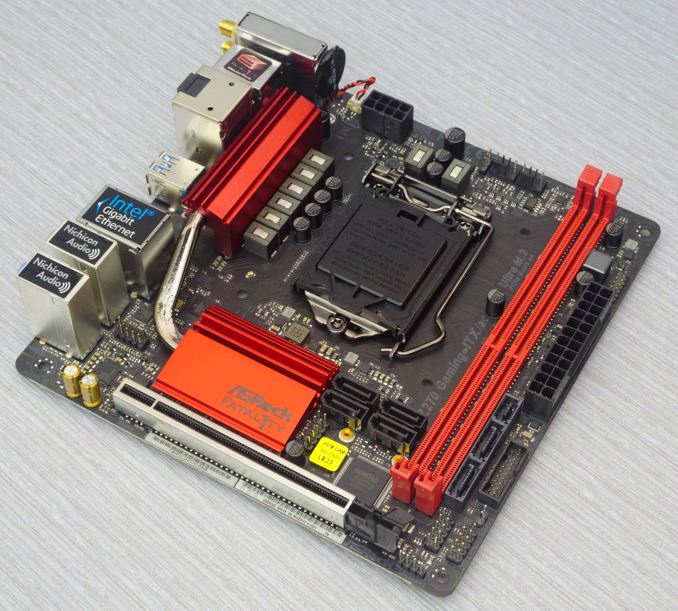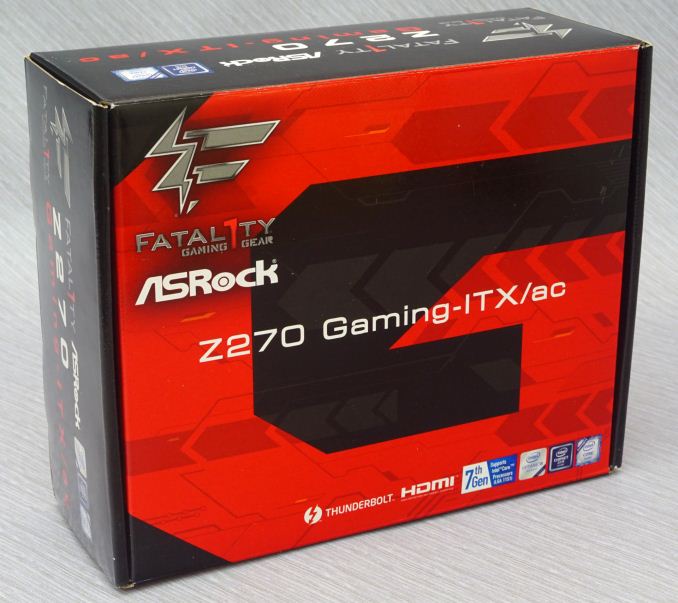The ASRock Fatal1ty Z270 Gaming-ITX/ac Motherboard Review
by E. Fylladitakis on September 19, 2017 9:00 AM EST- Posted in
- Motherboards
- Intel
- ASRock
- Mini ITX
- Z270
- 7700K
- Z270 Gaming ITX/ac

A few days back we had a look at a cost-effective Z270-based Mini ITX motherboard from ECS, the Z270H4-I Durathon 2, which we found to be a viable option for typical home users but hardly so for advanced gamers and enthusiasts. In this review we are having a look at a Mini ITX motherboard from ASRock, the Fatal1ty Z270 Gaming-ITX/ac. The concept and the design of the Z270 Gaming-ITX/ac are antithetical to those of the Z270H4-I Durathon 2, with ASRock trying to load the most and best possible features on the tiny Mini ITX motherboard, the result of which is an impressive list of features. Regardless, the retail price tag of the Z270 Gaming-ITX/ac is peculiarly reasonable for what ASRock claims it can offer.
The ASRock Z270 Gaming-ITX/AC Overview
After looking at its list of features, we feel as if someone challenged ASRock’s engineers to exhibit their skills on the Z270 Gaming-ITX/ac. From Thunderbolt 3 and dual band 802.11ac WiFi to HDMI 2.0 and SATA Express connectors, the sheer number of features that the specifications of the Z270 Gaming-ITX/ac list is profound for a Mini ITX motherboard. The designers also implemented advanced power circuitry and heatsinks that we normally see on ATX motherboards targeting advanced overclockers.
The audio circuitry of the Z270 Gaming-ITX/ac is interesting, with Realtek providing the advanced and popular ALC1220 CODEC. It supports the Creative Sound Blaster™ Cinema 3 and it has its front panel audio connector supported by an additional Texas Instruments NE5532 headset amplifier. Despite the small size of the ITX board, the sound circuitry is on an isolated part of the PCB. ASRock also implemented a HDMI 2.0 connector, allowing greater flexibility with high resolutions TVs and displays, as well as a versatile Thunderbolt 3 controller (Intel JHL6240).
Intel supplies both the controller (I-219V) of the single Gigabit port and the WiFi/Bluetooth combo chipset (AC 7265). The WiFi controller is dual band (2.4/5 GHz) and also supports Bluetooth 4.0/3.0. There are six SATA connectors on the motherboard, two of which can be combined to a single SATA Express connector. Due to space limitations, the sole M.2 slot is on the back side of the motherboard. It supports 2260/2280 PCIe ×4 or SATA devices. Note that the use of a SATA M.2 device disables one of the SATA 6Gb/s ports.
Overall, the little motherboard is trying to fulfill every desire of advanced gamers, overclockers and HTPC enthusiasts in one package. After going through the list of features, validating its performance and witnessing its overclocking capabilities, it became apparent that the designer of the Z270 Gaming-ITX/ac was trying to create a motherboard for the “ultimate” living room entertainment system, seeking to satisfy the needs of every advanced user into a single package.
| Motherboard Comparison | ||
| ASRock Z270 Gaming ITX/ac | ||
| Socket | LGA1151 | LGA1151 |
| MSRP at Review | $159 | $140 |
| DRAM | 2 x DDR4 | 4 x DDR4 |
| PCIe Layout | x16 | x8/x8 |
| BIOS Version Tested | 1.11 | 2.00 |
| MCT Enabled Automatically? | No | Yes |
| USB 3.1 (10 Gbps) | Intel JHL6240 | None |
| M.2 Slots | 1 x PCIe 3.0 x4 | 2 x PCIe 3.0 x4 |
| U.2 Ports | No | No |
| Network Controller | 1 x Intel I219-V | 1 x Intel I219-V |
| Audio Controller | Realtek ALC1220 | Realtek ALC892 |
| HDMI 2.0 | Yes | No |
Other AnandTech Reviews for Intel’s 7th Generation CPUs and 200-Series Motherboards
($110) The ECS Z270H4-I Durathon 2 Review
($140) The ASRock Z270 Killer SLI Review
($140) The MSI Z270 SLI PLUS Review
($170) The Asus Prime Z270-A
($170) The GIGABYTE Z270X-Ultra Gaming
The Intel Core i7-7700K (91W) Review - CPU Review
The Intel Core i5-7600K (91W) Review - CPU Review
The Intel Core i3-7350K (60W) Review - CPU Review
CPU Buyer's Guide: Q2 2017 - Guide
In comparison to the older Z170 boards, the new Z270 board on the base specifications are hardly any different. The Z270 ones have four extra PCIe lanes configurable on the chipset, potentially new audio and new networking controllers, and Intel Optane Technology Support. Although four extra PCIe lanes do sound like a huge difference, it is an important upgrade for the implementation of native M.2 slots (on Z170-based motherboards, this usually meant disabling some other device/port on the motherboard). Also, note that Intel Optane drives should still function on other chipsets as drives; the Z270 only allows them to enable their “smart caching” technology.
The Intel Optane Memory (SSD) Preview: 32GB of Kaby Lake Caching
Individual motherboard manufacturers will be sprinkling on new features onto their Z270 products to aid the transition and provide other tangible benefits over the old platform. To read specifically about the Z170 chip/platform and the specifications therein, our deep dive into what it is can be found at this link.
A Small Note on USB Naming
One thing that we should note is that the advent of the Z270 chipset brought a change on the naming of the USB ports. What we knew as USB 3.0 ports are now being dubbed as “USB 3.1 Gen 1” and the 10 Gbps ports are now called “USB 3.1 Gen 2”. We first encountered this change while reviewing the MSI Z270 SLI Plus a few months ago but it seems that most of the manufacturers are following suit, rewriting their websites and reprinting their manuals. Users need to be extra careful when very high bandwidth connectors are essential.












41 Comments
View All Comments
Gothmoth - Tuesday, September 19, 2017 - link
would love anandtech doing a in-depth VRM analysis like some youtube chanels do....i can read the specs myself on the manufacturer website.
spend some of that time on more useful things.
peterfares - Tuesday, September 19, 2017 - link
Why is there a SATA Express? I guess you can use it to connect U.2 drives right? But only at 2 lanes?DanNeely - Tuesday, September 19, 2017 - link
Probably equal parts design inertia, the sockets are cheaper than 2x sata because obsolete, and to support USB3.1g2 front panel devices. The latter needs 2 lanes of PCIe, so 1x slots aren't a good fit like for adding other forms of IO.BrokenCrayons - Tuesday, September 19, 2017 - link
It was sort of a cheap bandaid solution to the problem of SATA 3.0 bottlenecking contemporary SSDs that has never and probably won't ever take off since we now have M.2 interfaces instead. The idea was to quickly and cheaply double SATA 3.0 speeds in a backwards compatiable manner. Wikipedia has a pretty good article on it here if you want to know more:https://en.wikipedia.org/wiki/SATA_Express
OFelix - Tuesday, September 19, 2017 - link
I have the Z170 and used the feature to submit a support ticket direct from the BIOS.I was pleasantly surprised to receive a quick response from tech support.
On the Z170 I found that one of the fan headers would not allow speed control. Hopefully that has been fixed (review says that all fan headers support PWM).
Question: What devices could I buy today to use with SATA Express? Is it intended as internal or external expansion?
I want to build a system with multiple "personalities" by plugging in different external boot drives would thunderbolt or SATAe be suitable/better for this?
Thanks
Oxford Guy - Monday, September 25, 2017 - link
Good luck getting them to patch the BIOS for that board to fix the hyperthreading crash bug.Intel released the code to board makers in April. Here we are with AsRock sitting on its thumb.
punjabiplaya - Tuesday, September 19, 2017 - link
I've been running this board in my main rig since it launched. i7 7700k and a GTX1080 in a fractal nano. It's great.The_Assimilator - Tuesday, September 19, 2017 - link
Damn, that Thunderbolt chip is literally physically larger than the USB C port it's used for. Intel needs to slim that mofo way down if they want to fit it in the CPUs and/or south bridges, because that's the only way TB is ever gonna gain traction.DanNeely - Wednesday, September 20, 2017 - link
Yup. One of the reasons why really high speed IO is expensive, TB3 wasn't built into chipsets from the start, and why not all chipset USB ports are the fastest possible version is that doing it needs lots of transistors which means a relatively large amount of die size. You can see the same thing with USB3 only cards where the USB controller itself is the same size as the USBC port.ex
https://www.aliexpress.com/store/product/ASM1142-C...
only1jva - Tuesday, September 19, 2017 - link
I've owned this motherboard since March and it has begun to fail on me. After playing games like Civilization 6 and Xcom 2, the PC will completely freeze. After powering it down by holding down the power switch, I am unable to power it back on as the machine will turn on briefly then immediately shut down. It repeats this cycle over and over again. I have to wait half an hour to an hour before it turns back on completely.I'm running an i7-7700k AIO watercooler from Corsair, Asus GTX 1080, Corsair case. Not sure what the problem is with this thing but even if I can get into BIOS, it will freeze while in the BIOS screen. I've also tried all the released firmware versions for this board, they all behave the same.
so yeah, never trusting ASRock again.